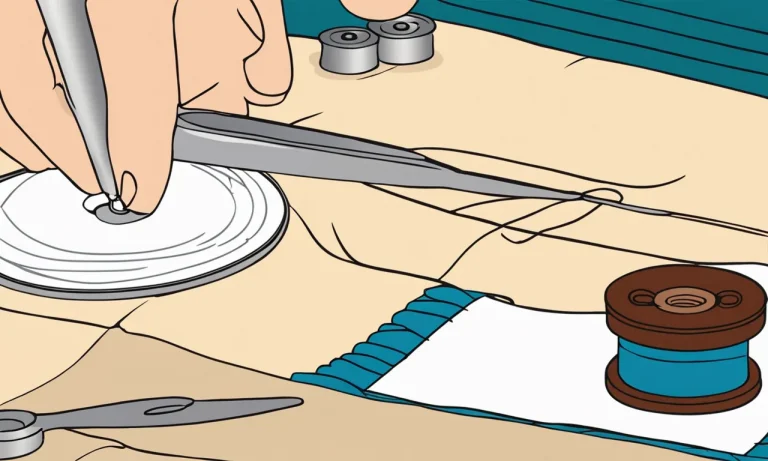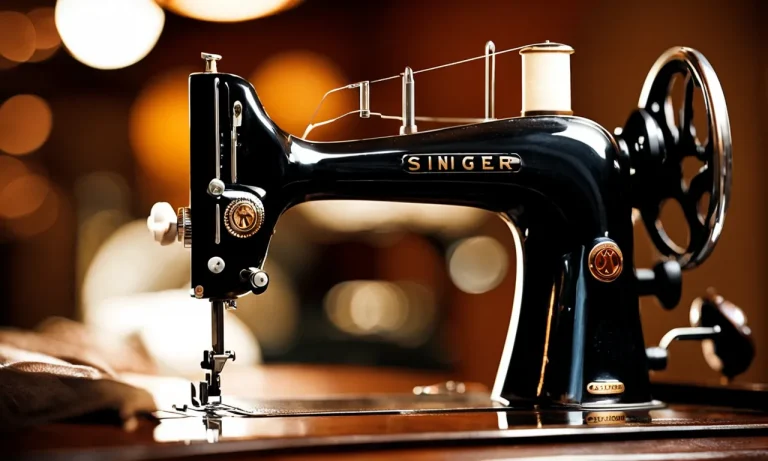Does Super Glue Work On Fabric? A Detailed Guide
If you’ve ever had a hole in your favorite shirt or lost a button on your pants, you may have wondered if super glue can fix fabric. Read on – we have the details on using super glue on fabric.
If you’re short on time, here’s a quick answer to your question: Super glue can work on some fabrics, but it has limitations. It forms a rigid bond that may not flex well with fabric and could damage more delicate materials.
What Is Super Glue?
Super glue, also known as cyanoacrylate adhesive, is a fast-acting adhesive that is commonly used to bond various materials together. It is a type of adhesive that forms a strong bond when it comes into contact with moisture in the air.
Super glue is known for its quick drying time, high strength, and versatility.
Chemical Composition and Properties
The main active ingredient in super glue is cyanoacrylate, which is a fast-curing adhesive that polymerizes in the presence of moisture. This chemical reaction creates a strong and durable bond between surfaces.
Super glue is transparent when dry and has a low viscosity, allowing it to penetrate into small cracks and gaps.
Super glue is known for its high bond strength, making it suitable for a wide range of applications. It can bond various materials such as metal, plastic, glass, and ceramics.
Designed for Hard Surfaces, Not Fabric
While super glue is highly effective on hard surfaces, it is not specifically designed for use on fabric. The adhesive properties of super glue may not work as effectively on fabric due to its porous nature.
Fabric materials, such as cotton, wool, or polyester, are more flexible and can absorb the glue, making it less effective in creating a strong bond.
When attempting to use super glue on fabric, it is important to consider the type of fabric and the intended use. In some cases, super glue may temporarily bond fabric together, but it may not withstand washing or everyday wear and tear.
It is recommended to use fabric glue or other adhesives specifically designed for fabric when working with textiles. These types of adhesives are formulated to bond fabric materials effectively and provide a durable bond that can withstand washing and stretching.
For more information on fabric adhesives and their applications, you can visit reputable websites such as The Spruce Crafts or Martha Stewart.
Factors That Determine If Super Glue Will Work
When it comes to using super glue on fabric, there are several factors that determine whether it will work effectively or not. Let’s take a closer look at two important factors: the type of fabric and the location and size of the repair.
Type of fabric
The type of fabric plays a crucial role in determining whether super glue will work. Fabrics that are porous or have a loose weave, such as cotton or linen, may not bond well with super glue. On the other hand, fabrics with a tight weave, such as polyester or nylon, tend to have better adhesion with super glue.
It is also important to consider the fabric’s ability to withstand heat. Super glue tends to work best on fabrics that can tolerate high temperatures without melting or warping. Always check the manufacturer’s guidelines or care instructions for your fabric before attempting to use super glue.
For delicate fabrics or those that are prone to damage, it is recommended to use fabric-specific adhesives or seek professional help to ensure a safe and effective repair.
Location and size of repair
The location and size of the repair also play a significant role in determining the effectiveness of super glue. Super glue works best on small, precise repairs rather than large areas of damage. If the repair area is too large, the glue may not penetrate the fabric evenly, resulting in a weak bond.
Additionally, the location of the repair can affect the durability of the bond. High-stress areas, such as seams or joints, may require additional reinforcement or stitching to ensure a long-lasting repair.
It is important to assess the location and size of the repair carefully before deciding to use super glue.
Remember, super glue is not a permanent solution for fabric repairs, and it may not work in all situations. If in doubt, it is always best to consult with a professional or consider alternative fabric repair methods.
For more information on fabric repairs and adhesive options, you can visit www.fabriclink.com or www.fabric.com.
Fabrics Super Glue Tends to Work On
Super glue is a versatile adhesive that can bond various materials together, including fabric. While it may not be the go-to option for all fabric repairs, it can be highly effective on certain types of fabrics. Here are some fabrics that super glue tends to work well on:
Denim
Denim is a durable and sturdy fabric commonly used in jeans and jackets. Super glue can be a great solution for repairing small tears or loose seams in denim. Its strong bonding properties make it ideal for securing denim fabric back together.
However, it’s important to apply the glue sparingly and precisely to avoid any visible residue or damage to the fabric.
Canvas
Canvas is another fabric that super glue can work effectively on. Whether you have a torn canvas bag, a loose seam on a canvas shoe, or a canvas painting that needs fixing, super glue can provide a quick and reliable solution.
It is important to apply the glue evenly on both sides of the fabric and press it firmly together until the glue sets. This will ensure a strong bond and a seamless repair.
Leather
Leather is a popular material used in various fashion items and accessories such as shoes, handbags, and belts. Super glue can be used to mend small damages in leather, such as tears or loose edges. It is important to note that not all types of super glue are suitable for leather.
Look for a super glue specifically designed for leather repairs to ensure the best results. Additionally, it’s a good idea to test the glue on a small, inconspicuous area of the leather before applying it to a visible spot.
Fabrics to Avoid Using Super Glue On
While super glue can be a handy adhesive for many materials, there are certain fabrics that you should avoid using it on. Super glue is designed to form a strong bond quickly, which can be detrimental to delicate fabrics. Here are some fabrics that you should be cautious about using super glue on:
Silk
Silk is a luxurious and delicate fabric that requires special care. Super glue can easily damage silk due to its strong adhesive properties. The glue can seep into the fabric, leaving behind unsightly stains and ruining the delicate texture of silk.
It’s best to avoid using super glue on silk and opt for fabric glue or other suitable alternatives instead.
Satin
Satin is another fabric that is prone to damage when exposed to super glue. The adhesive can penetrate the satin fibers, causing discoloration and potentially ruining the fabric’s smooth and shiny appearance.
If you need to repair or attach something to satin, it’s advisable to use fabric-specific glue or seek professional help to avoid any mishaps.
Wool
Wool is a warm and cozy fabric often used in winter clothing and blankets. However, using super glue on wool can lead to irreversible damage. The strong adhesive can cause the fibers to become stiff and brittle, affecting the overall quality and comfort of the fabric.
If you have a woolen item that needs repair, it’s best to consult a professional or use a fabric-specific adhesive that is safe for wool.
It’s important to note that these fabrics are just a few examples of materials that should be handled with care when it comes to using super glue. If you’re unsure about whether or not to use super glue on a particular fabric, it’s always best to do a test patch in an inconspicuous area before proceeding.
Application Tips for Using Super Glue on Fabric
Prepare the fabric
Before applying super glue on fabric, it is important to properly prepare the area to ensure the best adhesion. Start by cleaning the fabric to remove any dirt, oils, or stains that could interfere with the bonding process.
Use a mild detergent and warm water to gently wash the fabric, and allow it to dry completely before proceeding. If the fabric is delicate or prone to discoloration, it is recommended to test the super glue on a small, inconspicuous area first to ensure it does not damage the fabric.
Apply just a small amount
When using super glue on fabric, less is more. Apply only a small amount of glue to the desired area, as excessive glue can lead to unsightly residue or stiffening of the fabric. Gently squeeze a small drop of super glue onto a disposable surface, such as a plastic lid or wax paper, and use a toothpick or the tip of a small brush to apply the glue to the fabric.
Be cautious not to spread the glue too far beyond the intended area, as it can be difficult to remove excess glue once it has dried.
Let it fully cure
After applying super glue on fabric, it is crucial to allow sufficient time for it to fully cure. This typically takes around 24 hours, but curing time may vary depending on the type of fabric and the specific brand of super glue used.
During the curing process, it is important to avoid touching or moving the glued area to prevent any disruption to the bonding process. Additionally, it is recommended to place a heavy object, such as a book or a brick, on top of the glued area to ensure even pressure and a strong bond.
Remember, super glue is not suitable for all types of fabrics. While it can work well on materials like cotton, denim, or polyester, it may not adhere properly to more delicate fabrics like silk or satin.
If you are unsure about using super glue on a specific type of fabric, it is always best to consult the manufacturer’s instructions or seek professional advice.
For more information on using super glue on fabric, you can visit websites like Loctite Products or This to That, which provide detailed guides and tips for successful fabric bonding.
Conclusion
While super glue can work for some quick fabric repairs, it has limitations compared to fabric glues. Consider the type of fabric and the size of the repair. With care, super glue may be able to salvage your favorite pieces when used sparingly.
But for more flexible and long-lasting results, a dedicated fabric adhesive is a better choice.







